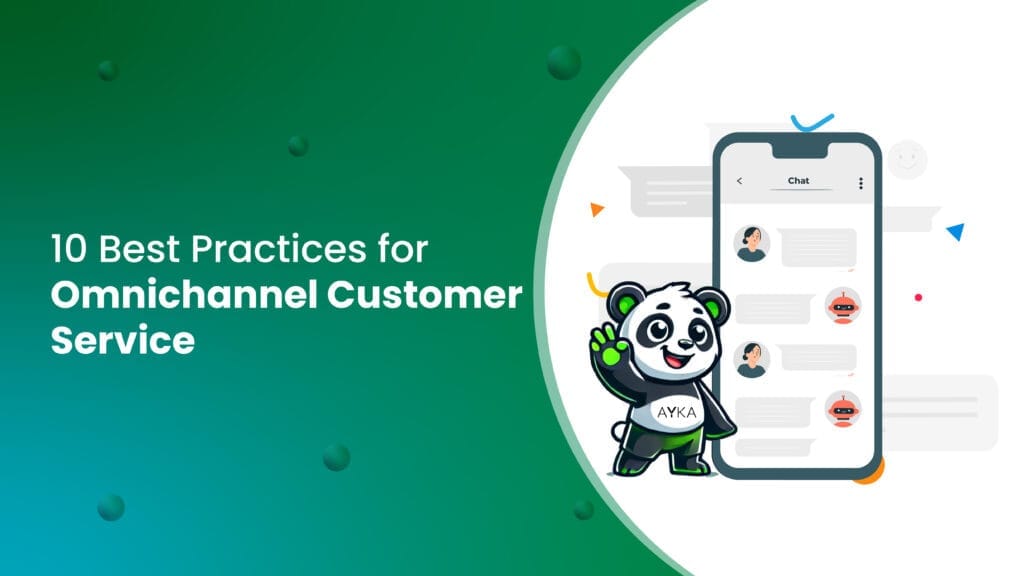15 Best Practices for Omnichannel Customer Service

Omnichannel customer service means providing seamless and connected support to customers across all the ways they interact with your business, such as email, phone, live chat, social media, or even in-person visits. The goal is to ensure every interaction feels smooth and unified, no matter which channel the customer chooses. For example, if a customer starts a conversation on chat and then switches to email or phone, they shouldn’t have to repeat their issue—everything should already be synced.
One key tool in achieving this is an Omnichannel chatbot. These chatbots are designed to work across multiple channels, ensuring customers receive instant and consistent responses no matter where they reach out. They can handle common queries, provide information, and even assist in resolving issues 24/7. By integrating an omnichannel chatbot into your system, businesses can enhance efficiency, reduce wait times, and deliver a better customer experience.
When combined with other tools, like a centralized system to manage customer data and automated workflows, businesses can ensure personalized and responsive service. This approach not only improves customer satisfaction but also helps build trust and loyalty over time, making it easier for customers to stay connected with your brand across any platform they prefer.
10 best practices for omnichannel customer service
1. Create Your Brand Book
A brand book defines your business’s identity. It explains how your brand looks, sounds, and interacts with customers.
- Consistent Voice: Make sure your brand uses the same tone on all platforms.
- Clear Guidelines: Provide instructions to your team on handling customer conversations.
- Unified Identity: Ensure your brand is easily recognized on every channel.
A brand book helps create a consistent experience, which builds trust with customers.
2. Understand Your Customers
To serve your customers better, you need to know what they want and how they feel.
- Ask for Feedback: Use surveys to learn what your customers like or dislike.
- Segment Your Audience: Group customers based on their preferences and behavior.
- Personalize Interactions: Respond to customers in ways that match their needs.
Understanding your customers helps you create personalized and meaningful communication.
3. Keep Your Website Updated
Your website is often the first place customers go to for help. An outdated website can frustrate them.
Tips for an Updated Website:
- Ensure it works well on both computers and phones.
- Add current product or service information.
- Include live chat for instant assistance.
- Improve loading speed to keep users from leaving.
An updated website makes it easy for customers to find what they need and connect with you.
4. Prioritize Quick Responses
Speedy responses improve customer satisfaction and create a sense of reliability.
- Fast Acknowledgments: Respond to all inquiries as quickly as possible.
- Real-time Support: Offer immediate help through chat and other instant channels.
- Track Response Times: Set standards and monitor agents’ response time to improve efficiency.
Quick replies enhance customer experience and create a sense of urgency and care.
5. Use Effective Communication Channels
Your customers want options to reach you. Offer multiple ways for them to communicate, such as:
- Social Media: Be active where your customers spend their time.
- Email: Reply to queries quickly and professionally.
- Phone: Minimize wait times and offer clear solutions.
- Live Chat: Provide instant help to customers when needed.
Connect these channels so customers can switch between them without repeating themselves.
6. Build a Reliable Dashboard
A dashboard collects all customer service data in one place, making your team’s job easier.
- Organized Workflow: Manage all queries efficiently.
- Quick Access: Agents can respond to questions faster.
- Performance Insights: Monitor how your team is doing and where improvements are needed.
A good dashboard simplifies operations and ensures smooth customer service.
7. Maintain Consistent Messaging
Consistency in messaging ensures your brand is always recognizable and trusted.
- Uniform Tone: Maintain the same voice and style across all communication channels.
- Brand Guidelines: Provide clear rules for tone, language, and approach to support agents.
- Clarity Across Platforms: Ensure customers receive the same message, regardless of platform.
Consistency builds trust, making your brand more reliable and approachable to customers.
8. Track Customer Interactions
Keep a record of every interaction so you can provide better service in the future.
- Use CRM Software: Tools like SalesTown store customer details and history.
- Analyze Data: Learn from previous interactions to predict what customers need.
- Follow-up: Check back with customers to resolve pending issues.
Tracking interactions makes it easier to offer personalized and efficient support.
9. Collect Regular Feedback
Customer feedback helps you identify areas for improvement.
- Ask for Opinions: Use surveys, reviews, or direct calls.
- Take Action: Fix issues based on what customers say.
- Involve Your Team: Discuss feedback during team meetings to find solutions.
Regular feedback sessions keep your customer service aligned with customer expectations.
10. Switch to a Cloud-Based System
A cloud-based system is essential for managing omnichannel customer service.
Why Use Cloud-Based Systems?
- Real-Time Updates: Access the latest information instantly.
- Flexibility: Add new features as your business grows.
- Remote Work: Allow your team to work from anywhere without interruptions.
Cloud systems improve efficiency and help your team deliver consistent service.
11. Balance Human and Automated Responses
A mix of human and automated communication creates the best customer experience.
- Chatbots: Use AI to handle simple questions and save time.
- Human Support: Assign complex problems to experienced agents.
- Monitoring: Ensure chatbot responses match your brand’s voice and standards.
This combination keeps your service fast and personal.
12. Stay Ahead of Competitors
To lead in your industry, you need to constantly improve your customer service.
- Research Competitors: Learn what others are doing and find ways to do it better.
- Be Innovative: Use new tools and ideas to enhance customer experiences.
- Train Your Team: Regularly update your team’s skills to meet modern demands.
Staying ahead ensures your business remains the top choice for customers.
13. Provide Self-Service Options
Allow customers to resolve issues independently, empowering them with resources.
- Knowledge Base: Offer detailed FAQs and help articles.
- Self-Help Portals: Create easy-to-navigate portals for troubleshooting.
- Community Forums: Enable customers to interact and find solutions together.
Self-service reduces wait times and helps customers find quick answers to common issues.
14. Optimize for Mobile
Ensure all services and interactions are mobile-friendly for on-the-go customers.
- Responsive Design: Optimize websites and apps for mobile devices.
- Mobile Communication: Offer text or app-based support options.
- Easy Navigation: Ensure customers can easily navigate services on small screens.
Optimizing for mobile ensures a seamless experience for customers across all devices.
15. Regularly Update Your Strategy
Constantly evaluate and adjust your strategy to meet changing customer expectations.
- Review Customer Trends: Keep up with evolving customer preferences and behaviors.
- Test New Channels: Experiment with emerging platforms or tools to stay relevant.
- Adapt to Changes: Be flexible and update your strategy as needed.
Regular updates ensure that your omnichannel approach remains effective and aligned with customer needs.

Benefits of Omnichannel Customer Service
Implementing these practices offers several advantages:
- Happier Customers: Customers get quick, easy help no matter how they contact you.
- Consistent Service: The help you offer is the same across all channels, so customers always get reliable support.
- Loyal Customers: Personalized and helpful service makes customers more likely to come back.
- Better Understanding of Customers: You collect important details from all customer interactions, helping you improve service.
- Faster and Easier Support: Customers don’t have to repeat themselves, and agents can resolve issues quicker.
- More Ways to Reach You: Customers can contact you through their preferred channel, like social media or email.
Conclusion
Omnichannel customer service is a game-changer for businesses that want to succeed in today’s market. By following these 10 best practices, you can provide a smooth and efficient experience that keeps customers satisfied.
Invest in the right tools, train your team, and focus on what your customers need. With a strong omnichannel strategy, your business will stand out and thrive.


